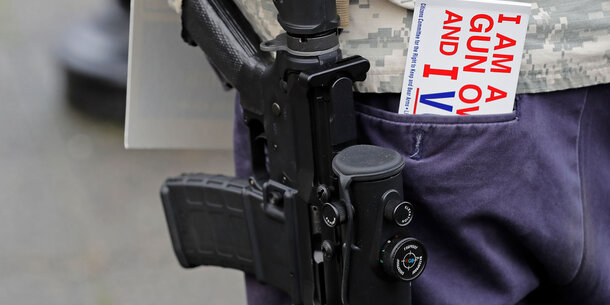This piece originally appeared at the Duke Center for Firearms Law.
It’s become an all-too-familiar scenario: a gun owner becomes scared that a protester or mere passerby could endanger him and brandishes a gun. The gun owner then asserts that the rights to self-defense and to keep and bear arms protect him from prosecution. This line of argument, which is playing out in the McCloskey case in St. Louis, greatly misconstrues the scope of the Second Amendment and how self-defense actually works as a defense to criminal charges.
Mark and Patricia McCloskey became frightened when Black Lives Matter protesters marched along the sidewalk in front of their house. The circumstances are disputed, though it appears that they live in a private, gated community. Video does not show the protesters ever leaving the sidewalk, but Mr. McCloskey said he was afraid the protesters “would run me over, kill me, [and] burn my house.” He and his wife grabbed a semiautomatic rifle and handgun and confronted the protesters. Video shows Ms. McCloskey with her finger on the trigger, aiming at one protester after another as they walked by.
This week, the couple was charged by the St. Louis prosecutor with unlawful use of a weapon and fourth-degree assault. The uproar about the prosecution was swift, even coming from some national Republican figures like Sen. Josh Hawley and President Trump. In an extraordinary move, Eric Schmitt, Missouri’s attorney general, urged dismissal of the local charges. He argued that the prosecution “threatens to intimidate and deter” Missourians from exercising their rights to self-defense and to keep and bear arms. “Missourians,” Schmitt wrote, “should not fear exposure to criminal prosecution when they use firearms to defend themselves and their homes from threatening intruders.” In Twitter posts, he conflated the Second Amendment and self-defense, asserting that “[c]itizens shouldn’t be targeted for exercising their #2A right to self-defense.”
Schmitt’s argument might make for good politics, but it confuses the law of self-defense and the Second Amendment. From the very beginning of our nation’s history, and dating back even further to the English common law tradition, a person engaging in a violent act, including threatening violence, is exposed to prosecution. They can argue to the judge and jury that they were justified or excused in their conduct, but whether they succeed in their defense is ultimately not theirs alone to decide.
It’s always been this way, and for a reason. A basic goal of government is minimizing private violence, which is why we criminalize acts of physical aggression in the first place. Lawful self-defense operates as an exception to this general sanction, and it is a carefully circumscribed one. Generally speaking, defensive force, such as the brandishing of firearms, is only justified if necessary and proportionate to a reasonably perceived threat. The requirements of necessity and proportionality apply no matter whether someone is in a duty-to-retreat or stand-your-ground jurisdiction, or whether someone is in their home or in public. As one well-known self-defense opinion comments, “‘[t]he law of self-defense is a law of necessity’; the right of self-defense arises only when the necessity begins, and equally ends with the necessity.” These requirements reflect, as English jurist Edward Coke wrote, the “precious regard the Law hath of the life of man.”
The McCloskeys have every right to argue that the requirements of self-defense were met under Missouri law, including its version of the castle doctrine. But that determination is ultimately not up to them, but rather is up to the judge or jury. This, too, is as it should be. The alternative — which Attorney General Schmitt apparently favors — is that gun owners get to decide for themselves whether they are justified in using their guns. That’s a dangerous and lawless position that almost certainly would lead to unnecessary shows of force. One study found, for example, that a majority of self-reported self-defense gun uses are probably illegal. Illegal defensive gun use poses an especially troubling risk to Black men and women, like those at the St. Louis protest, who are more likely to be misperceived as a threat.
Schmitt also invokes the Second Amendment, but the right to keep and bear arms does not subvert the traditional operation of self-defense law. The Second Amendment protects the right to “keep and bear” an arm, not to “keep, bear, wave, and shoot” it. The right to keep and bear arms is, and always has been, “auxiliary” (to borrow William Blackstone’s term) to self-defense. The Supreme Court in District of Columbia v. Heller repeated this understanding when it held that the “core” interest served by the right to keep and bear arms is lawful self-defense. The Court could not possibly have thought that its decision was thereby undoing the centuries-long tradition of using the criminal process to determine when defensive weapons use is lawful.
The debate over the St. Louis case is reflective of today’s gun politics — not a reflection of the proper operation of the law. The case should run its course the same as any other prosecution. Anything else would mark a sharp turn away from the traditional way we prevent unlawful threats and violence in this country.
Eric Ruben is an assistant professor of law at SMU Dedman School of Law and a Brennan Center fellow.






